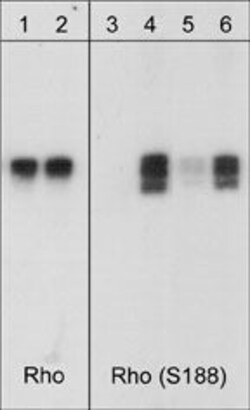Promotional price valid on web orders only. Your contract pricing may differ. Interested in signing up for a dedicated account number?
Learn More
Learn More
Invitrogen™ Phospho-RHOA (Ser188) Polyclonal Antibody


Rabbit Polyclonal Antibody
Supplier: Invitrogen™ PA5143758
Description
The antibody detects a RhoA GST fusion protein when phosphorylated with PKA, but does not detect the unphosphorylated recombinant protein.
RhoA regulates a signal transduction pathway linking plasma membrane receptors to the assembly of focal adhesions and actin stress fibers. It is involved in a microtubule-dependent signal that is required for the myosin contractile ring formation during cell cycle cytokinesis, and plays an essential role in cleavage furrow formation. RhoA is required for the apical junction formation of keratinocyte cell-cell adhesion, and serves as a target for the yopT cysteine peptidase from Yersinia pestis, vector of the plague, and Yersinia pseudotuberculosis, which causes gastrointestinal disorders. RhoA stimulates PKN2 kinase activity and may be an activator of PLCE1. It is activated by ARHGEF2, which promotes the exchange of GDP for GTP. It is essential for the SPATA13-mediated regulation of cell migration and adhesion assembly and disassembly. The MEMO1-RHOA-DIAPH1 signaling pathway plays an important role in ERBB2-dependent stabilization of microtubules at the cell cortex. It controls the localization of APC and CLASP2 to the cell membrane, via the regulation of GSK3B activity. In turn, membrane-bound APC allows the localization of the MACF1 to the cell membrane, which is required for microtubule capture and stabilization.
Specifications
| Phospho-RHOA (Ser188) | |
| Polyclonal | |
| Unconjugated | |
| RHOA | |
| Aplysia ras-related homolog 12; Aplysia RAS-related homolog 6; aplysia ras-related homolog A; aplysia ras-related homolog A1; aplysia ras-related homolog A2; ARH12; ARH6; ARH9; ARHA; Arha1; Arha2; ARHB; ARHC; h12; h6; H9; MGC72339; MST081; MSTP081; oncogene RHO H12; oncogene RHO H6; oncogene RHO H9; plysia ras-related homolog A2; Ras family member A; ras homolog A1; ras homolog A2; ras homolog family member A; ras homolog family member B; ras homolog family member C; ras homolog gene family, member A; ras homolog gene family, member A1; ras homolog gene family, member A2; ras homolog gene family, member B; ras homolog gene family, member C; RAS-related homolog 9; Rho; Rho cDNA clone 12; Rho cDNA clone 6; rho cDNA clone 9; Rho family GTPase; RHO12; Rhoa; RHOB; RHOC; rhoC GTPase; RHOH12; RHOH6; RHOH9; rho-related GTP-binding protein RhoB; Rho-related GTP-binding protein RhoC; small GTP binding protein RhoA; small GTP binding protein RhoC; transforming protein RhoA | |
| Rabbit | |
| Antigen Affinity Chromatography | |
| RUO | |
| 117273, 11848, 387 | |
| -20°C, Avoid Freeze/Thaw Cycles | |
| Liquid |
| Western Blot | |
| 0.5 mg/mL | |
| PBS with 1mg/mL BSA, 50% glycerol and 0.05% sodium azide | |
| P61586, P61589, Q9QUI0 | |
| RHOA | |
| Phospho-RhoA (Ser-188) synthetic peptide (coupled to KLH) corresponding to amino acid residues around serine 188 of human RhoA. This peptide sequence is highly conserved in rat, mouse, and chicken RhoA, but is not found in RhoB or RhoC proteins. | |
| 100 μL | |
| Primary | |
| Human, Mouse, Rat | |
| Antibody | |
| IgG |
Product Content Correction
Your input is important to us. Please complete this form to provide feedback related to the content on this product.
Product Title
Spot an opportunity for improvement?Share a Content Correction
